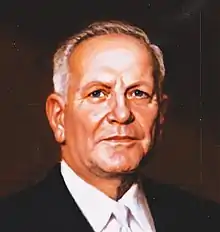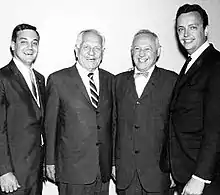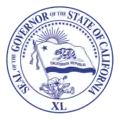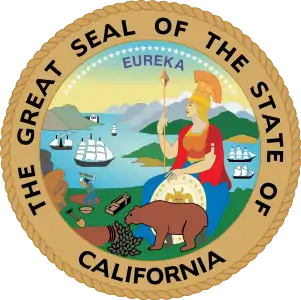Goodwin Knight
Goodwin Jess "Goodie" Knight (December 9, 1896 – May 22, 1970) was an American politician who was the 31st Governor of California, serving from 1953 until 1959.[1]
Goodwin Knight | |
|---|---|
 | |
| 31st Governor of California | |
| In office October 5, 1953 – January 5, 1959 | |
| Lieutenant | Harold J. Powers |
| Preceded by | Earl Warren |
| Succeeded by | Pat Brown |
| 35th Lieutenant Governor of California | |
| In office January 7, 1947 – October 5, 1953 | |
| Governor | Earl Warren |
| Preceded by | Frederick F. Houser |
| Succeeded by | Harold J. Powers |
| Personal details | |
| Born | Goodwin Jess Knight December 9, 1896 Provo, Utah, U.S. |
| Died | May 22, 1970 (aged 73) Inglewood, California, U.S. |
| Political party | Republican |
| Spouse(s) | Arvilla Cooley
(m. 1925; died 1952)Virginia Carlson (m. 1954) |
| Children | 2 |
| Alma mater | Stanford University |
| Profession | Judge |
| Military service | |
| Allegiance | |
| Branch/service | |
| Years of service | 1918-1919 |
| Rank | |
| Battles/wars | World War I |
Biography
Early years
Knight was born in Provo, Utah, but his family moved to Los Angeles when he was a boy. His father, Jesse Jasper Knight (nephew of mining magnate Jesse Knight), was a mining engineer, but Goodwin followed in his mother's (Lille) father's (his grandfather John B. Milner) footsteps. This grandfather was a judge in Provo.
Knight attended high school in Los Angeles, at Manual Arts High School. One of his classmates was Jimmy Doolittle. He earned an A.B. in Law and Business from Stanford University, where he was a member of the Stanford Chaparral, in 1919. Knight also attended Cornell University. He served in the U.S. Navy during World War I.
Career
Knight was a judge of the Superior Court in Los Angeles beginning in 1935. He was reelected in 1936 and 1942 without significant opposition. His case load varied from the glamorous to the mundane. He oversaw weddings and divorces for Hollywood starlets.

Political career and governor of California
Knight began his political career in 1944, when he pursued the Republican nomination for the U.S. Senate. He bowed out early, though, to back Fred Houser. He was elected as the 35th Lieutenant Governor of California to serve under Governor Earl Warren in 1946, then reelected in 1950. He became governor himself when Warren resigned to become Chief Justice of the United States in 1953.
While Lieutenant Governor he made a guest appearance on the Jack Benny show, an episode from San Francisco.
As governor, Knight fought for control of the Republican Party of California with U.S. Senate Majority Leader William Knowland and Vice President Richard Nixon. In 1954, Knight was easily elected to his own full term. At first Knight seemed to make an alliance with Knowland, but this began to sour in 1956 when Knowland supported Nixon for renomination as vice president. In 1957, Knowland announced that he would challenge Knight in the 1958 Republican primary for governor. Knight, known as a moderate, and sympathetic to organized labor, faced a serious threat from more conservative challengers. He was induced by Knowland, Nixon, President Dwight Eisenhower, and others to run for Knowland's Senate seat instead of running for governor again. Both Knowland and Knight went down in defeat in 1958, with Knowland losing the gubernatorial race to Edmund G. "Pat" Brown, Sr. and Knight losing the Senate race by over 10% to Clair Engle, severely weakening the heretofore-dominant Republicans in the state. This left Nixon in control of the California party and in line for the presidential nomination, which Knowland and Knight had also desired.
Knight was present at the July 17, 1955, opening of Disneyland, and gave a speech following Walt Disney's famous dedication.
In September 1961, Knight announced a bid for a return to the governorship. He later dropped out of the race for the Republican nomination which was won by Nixon, who was in turn defeated by Brown.[2]
In 1964, Knight endorsed Nelson Rockefeller for the Republican nomination against Barry Goldwater. Rockefeller was unsuccessful in stopping Goldwater, the darling of the party's growing conservative wing. Knight never ran for political office again.
Personal life
Knight's first wife, Arvilla, died of a heart attack on October 29, 1952; the couple had two daughters. He married Virginia Carlson (born Virginia Piergue on October 12, 1918 in Fort Dodge, Iowa), the widow of an Army Lieutenant, on August 2, 1954 at the Episcopal Church of Our Savior in Los Angeles.[3] The couple had no children.
Death
On May 22, 1970, Knight died three months after his daughter Carolyn Knight Weedman committed suicide. She took her life by carbon monoxide asphyxiation from her car in the garage of her home on Lillian Way in Hancock Park and left behind two sons, Jonathan and Robert Weedman. Knight discovered his daughter a day later, and this is believed to have contributed to the stroke that ultimately ended his life. His widow, Virginia, never remarried, and died on November 29, 2010.[4]
Goodwin Knight's funeral took place in Saint James Episcopal Church in Los Angeles, with full military honors. The funeral was attended by then California Governor Ronald Reagan, Arizona Senator Barry Goldwater and his son, California U.S. Representative Barry Goldwater Jr., General of the Army Omar Bradley and numerous Hollywood and civic leaders. Knight was initially interred at Hollywood Memorial Park Cemetery, but one year later disinterred and his remains moved to Rose Hills Memorial Park in Whittier, California after his second wife Virginia Knight learned he had purchased a crypt next to his first wife Arvilla.
See also
References
- Staff writers (1 June 1970). "Milestones". Time. Retrieved 5 December 2011.
- "Goodwin J. Knight of California Dies". The New York Times. 23 May 1970. p. 22.
- Knight, Virginia; Stein, Mimi Feingold; Sharp, Sarah (1987). California's First Lady, 1954-1958. Berkeley: Regents of the University of California.
- Valerie J. Nelson (December 1, 2010). "Virginia Knight dies at 92; former first lady of California". The Los Angeles Times. p. AA7. Retrieved 5 December 2011.
External links
- Goodwin J. Knight Political History
- Biography and Inaugural speeches
- American Legion in Utah - Politician members
- Finding aid for Goodwin J. Knight Oral History, Dwight D. Eisenhower Presidential Library
| Party political offices | ||
|---|---|---|
| Preceded by Earl Warren |
Republican nominee for Governor of California 1954 |
Succeeded by William F. Knowland |
| Preceded by William F. Knowland |
Republican nominee for U.S. Senator from California (Class 1) 1958 |
Succeeded by George Murphy |
| Political offices | ||
| Preceded by Frederick F. Houser |
Lieutenant Governor of California 1947–1953 |
Succeeded by Harold J. Powers |
| Preceded by Earl Warren |
Governor of California 1953–1959 |
Succeeded by Pat Brown |

